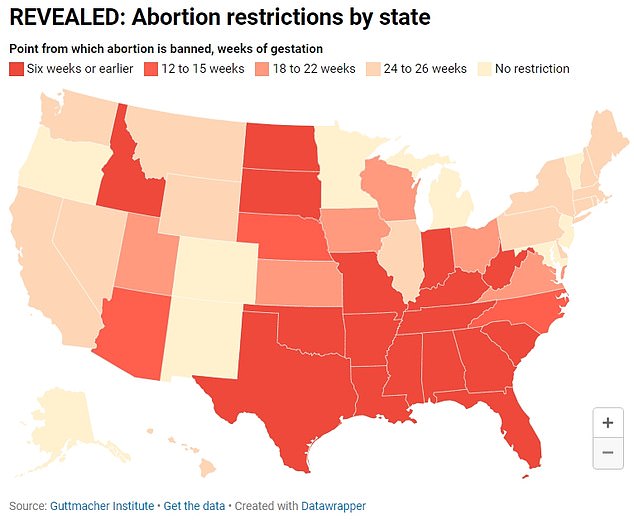The landscape of abortion law in the United States has been revealed in an interactive map on DailyMail.com.
More than 17 states, mostly in the South, have enacted abortion bans that prohibit virtually all procedures, since the law only allows it before six weeks, when most women do not know they are pregnant.
At the other end of the scale, nine states (Alaska, Colorado, Maryland, Michigan, Minnesota, New Jersey, New Mexico, Oregon and Vermont) have no legal restrictions on abortion.
Meanwhile, 18 states allow abortion up to 26 weeks, or just under six months. However, most doctors will not perform them after 21 weeks unless there is a serious medical reason.
At around 24 weeks, some healthy fetuses can survive outside the womb.
The map above shows states by their abortion restrictions. It reveals a divide between parties and regions, with the South most likely to restrict abortions.
The surge in legislation came after the overturning of Roe v Wade, the landmark 1973 legal case that protected the right of women in every state to have an abortion until 2022.
Despite the change, data suggests that abortions in the United States are increasing and last year reached their highest level since 2014.
It is estimated that a total of one million abortions were performed in 2023, an increase of 11 percent from 2020. However, this figure is still below the all-time high set in 1990, of 1.6 million in one year.
Experts say the recent rise has been fueled by the introduction of rules that allowed abortion pills to be sent to patients by mail, without requiring an appointment with a doctor.
The move came in December 2021 in response to the pandemic, which prevented Americans from accessing in-person health care.
The medications are only available by prescription and must be taken during the first ten weeks of pregnancy.
In an early-stage medication abortion, patients take two medications; mifepristone and then a second medicine called misoprostol about 24 to 48 hours later.
More than nine out of ten abortions performed in the U.S. occur before week 13, and less than one percent occur after week 21. A typical pregnancy lasts 40 weeks.
Doctors say abortions are rarely performed after 21 weeks, and are typically only performed after this point due to fetal abnormalities or if the mother’s life is in danger.

Critics say abortion bans below six weeks are too early for women to know they are pregnant and take action (Image of abortion rights protection in Washington in March)

Data suggests abortions are increasing in the US: 1 million were performed in 2023, the latest year available, the most since 2014.
Abortion restrictions by state were revealed by the Guttmacher Institute, a New York City-based think tank that campaigns for greater access to abortion.
The researchers collected information on abortion limits by state through news reports and legislation within each state’s House and Senate.
The map shows a major divide on abortion along partisan lines, with Democratic states mostly protecting abortion up to 24 weeks and Republican states mostly seeking to ban it entirely.
Southern states, where legislators tend to be more religious, are much more likely to virtually ban abortion compared to other areas.
One of the most restrictive states was Alabama, where abortions are practically impossible: they are prohibited from the moment the egg is fertilized.
Many other red states, including Arkansas, Mississippi and North Dakota, also follow this rule.
Others include Florida, South Carolina and Georgia, which have implemented a six-week abortion ban.
This is based on claims that fetal heartbeats can be detected as early as six weeks, although doctors say a developing embryo does not actually have a heart at this time.
It is not clear when exactly the heart starts beating.
On the other hand, laws are much less restrictive in states like Oregon, where lawmakers have not placed any restrictions on “gestational age-based abortion” but instead let doctors make the decision.
Three US states (Arizona, Nebraska and North Carolina) also set the abortion limit at 12 to 15 weeks, which they say gives women enough time after discovering they are pregnant to take action.
Utah is currently the only state that prohibits abortion after 18 weeks of pregnancy, which was agreed to by lawmakers.
And Kansas and Ohio have previously set limits of 22 weeks, which they say is when a fetus is viable outside the womb.
Some U.S. states often compare their laws to those in Europe, pointing to countries like the United Kingdom and the Netherlands that allow abortions up to 24 weeks on the basis that this is when the fetus becomes viable outside the womb.
But these nations are outliers on the continent, with most (including France and Germany) setting an abortion limit between 12 and 15 weeks.
However, this carries multiple medical exceptions, including fetal malformations, harm to the mother’s health, and psychological or economic distress.


